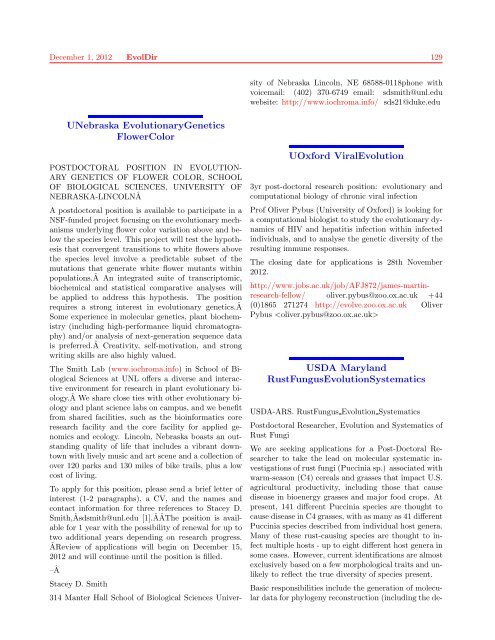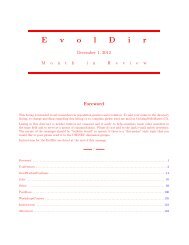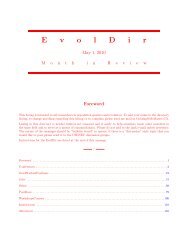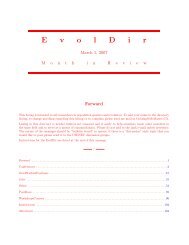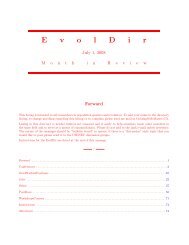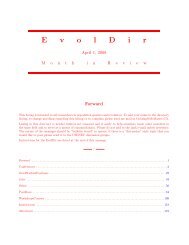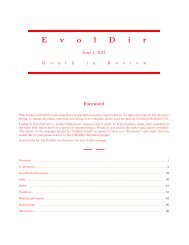E v o l D i r
E v o l D i r
E v o l D i r
Create successful ePaper yourself
Turn your PDF publications into a flip-book with our unique Google optimized e-Paper software.
December 1, 2012 EvolDir 129<br />
UNebraska EvolutionaryGenetics<br />
FlowerColor<br />
POSTDOCTORAL POSITION IN EVOLUTION-<br />
ARY GENETICS OF FLOWER COLOR, SCHOOL<br />
OF BIOLOGICAL SCIENCES, UNIVERSITY OF<br />
NEBRASKA-LINCOLN Â<br />
A postdoctoral position is available to participate in a<br />
NSF-funded project focusing on the evolutionary mechanisms<br />
underlying flower color variation above and below<br />
the species level. This project will test the hypothesis<br />
that convergent transitions to white flowers above<br />
the species level involve a predictable subset of the<br />
mutations that generate white flower mutants within<br />
populations. Â An integrated suite of transcriptomic,<br />
biochemical and statistical comparative analyses will<br />
be applied to address this hypothesis. The position<br />
requires a strong interest in evolutionary genetics. Â<br />
Some experience in molecular genetics, plant biochemistry<br />
(including high-performance liquid chromatography)<br />
and/or analysis of next-generation sequence data<br />
is preferred. Â Creativity, self-motivation, and strong<br />
writing skills are also highly valued.<br />
The Smith Lab (www.iochroma.info) in School of Biological<br />
Sciences at UNL offers a diverse and interactive<br />
environment for research in plant evolutionary biology.<br />
 We share close ties with other evolutionary biology<br />
and plant science labs on campus, and we benefit<br />
from shared facilities, such as the bioinformatics core<br />
research facility and the core facility for applied genomics<br />
and ecology. Lincoln, Nebraska boasts an outstanding<br />
quality of life that includes a vibrant downtown<br />
with lively music and art scene and a collection of<br />
over 120 parks and 130 miles of bike trails, plus a low<br />
cost of living.<br />
To apply for this position, please send a brief letter of<br />
interest (1-2 paragraphs), a CV, and the names and<br />
contact information for three references to Stacey D.<br />
Smith, Âsdsmith@unl.edu [1].ÂÂThe position is available<br />
for 1 year with the possibility of renewal for up to<br />
two additional years depending on research progress.<br />
ÂReview of applications will begin on December 15,<br />
2012 and will continue until the position is filled.<br />
– Â<br />
Stacey D. Smith<br />
314 Manter Hall School of Biological Sciences Univer-<br />
sity of Nebraska Lincoln, NE 68588-0118phone with<br />
voicemail: (402) 370-6749 email: sdsmith@unl.edu<br />
website: http://www.iochroma.info/ sds21@duke.edu<br />
UOxford ViralEvolution<br />
3yr post-doctoral research position: evolutionary and<br />
computational biology of chronic viral infection<br />
Prof Oliver Pybus (University of Oxford) is looking for<br />
a computational biologist to study the evolutionary dynamics<br />
of HIV and hepatitis infection within infected<br />
individuals, and to analyse the genetic diversity of the<br />
resulting immune responses.<br />
The closing date for applications is 28th November<br />
2012.<br />
http://www.jobs.ac.uk/job/AFJ872/james-martinresearch-fellow/<br />
oliver.pybus@zoo.ox.ac.uk +44<br />
(0)1865 271274 http://evolve.zoo.ox.ac.uk Oliver<br />
Pybus <br />
USDA Maryland<br />
RustFungusEvolutionSystematics<br />
USDA-ARS. RustFungus Evolution Systematics<br />
Postdoctoral Researcher, Evolution and Systematics of<br />
Rust Fungi<br />
We are seeking applications for a Post-Doctoral Researcher<br />
to take the lead on molecular systematic investigations<br />
of rust fungi (Puccinia sp.) associated with<br />
warm-season (C4) cereals and grasses that impact U.S.<br />
agricultural productivity, including those that cause<br />
disease in bioenergy grasses and major food crops. At<br />
present, 141 different Puccinia species are thought to<br />
cause disease in C4 grasses, with as many as 41 different<br />
Puccinia species described from individual host genera.<br />
Many of these rust-causing species are thought to infect<br />
multiple hosts - up to eight different host genera in<br />
some cases. However, current identifications are almost<br />
exclusively based on a few morphological traits and unlikely<br />
to reflect the true diversity of species present.<br />
Basic responsibilities include the generation of molecular<br />
data for phylogeny reconstruction (including the de-


